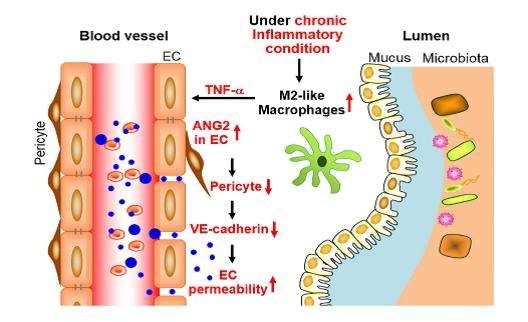Team identifies mechanisms of inflammation-induced animal aging

DGIST's research team has experimentally proved the hypothesis that the accumulated chronic inflammation results in the aging of animals.
Research team led by the chair professor Sang-Cheol Park has identified the aging mechanisms of animals resulting from intestinal inflammation accumulation through the joint research with professor Hyun E. Choy's research team of Chonnam National University.
So far, numerous hypotheses explaining animal aging have been published and one of them is inflammation-induced aging which proposes that accumulation of inflammation is the cause of animal aging. While inflammation-induced aging theory has been one of many hypotheses explaining the aging of animals, its substance has not been clearly proven.
Chair-Professor Sang-Cheol Park's research team has discovered that the pericytes surrounding the endothelial cells in the intestinal tissues decrease as an animal's biological age increases and thus the blood vessel function deteriorated, including the progress of vascular leakage.
Through the experiment, this study has shown that this phenomenon is due to the increase of gut-resident inflammatory cells (macrophages) and the increase of TNF-α, cytokine secreted by these cells, as well as the entailed changes in the surrounding environment of blood vessel.
The team has not only experimentally proved the hypothesis of inflammation-induced aging, but also identified that it could be an important clue to slow the aging process through inflammation control and vascular leakage inhibition in the mice experiment.
DGIST's Chair-Professor Sang-Cheol Park said, "This study is significant as we have newly identified the mechanisms of aging associated with inflammation increase and opened possibilities of applied researches on aging delay through inflammation control as well as anti-aging. We will conduct follow-up studies to find ways to extend human health life by controlling inflammatory cells and vascular leakage to delay aging."
This study will open a new chapter in anti-aging, a long standing challenge for mankind. It is expected that the follow-up studies on intestinal inflammation control will make a great contribution to the development of various technologies that can practically delay aging. For these purposes, it is required to explore a variety of candidate substances that are able to control gut-resident inflammation and conduct clinical researches on them.
More information: Jae-Ho Jeong et al, Microvasculature remodeling in the mouse lower gut during inflammaging, Scientific Reports (2017). DOI: 10.1038/srep39848














